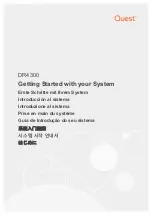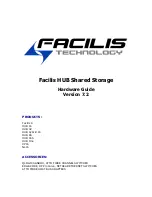
Glossary
Backup
The creation of an additional copy of data onto a different location than
the existing data and can be retrieved at a later time.
Bit
Also know as a binary digit. The smallest measure of data. A bit can be a
1 or a 0. One character is equal to one byte or 8 bits.
Byte
A sequence or series of binary digits (also known as bits). A byte is 8 bits.
Cross-Platform
Any device that can operate on both Macintosh and Windows operating
systems.
Driver
A software component that allows a computer to communicate with a
peripheral. Different drivers are appropriate for different peripherals.
File System
System that links the physical map of a disk to its logical structure.
Firmware
Semi-permanent of permanent instructions programmed directly into a
read only memory or memory chip. Firmware is used in controlling the
operation of a computer or drive. Firmware is different from software.
Folder
An area on a disk to store files. Folders help in organizing and storing
data in a logical manner.
Format
The process where a device can record data. The hard disk writes
information onto its own surface areas (called blocks). Formatting causes
all current data on the disk to be loss.
GB (Gigabyte)
One billion bytes. Usually associated with storage.
Hardware
The physical components of a computer system. This includes the
peripherals.
Host Bus Adapter (HBA)
A printed circuit board also called a controller.
Host Computer
Any computer system to which disks are directly attached and accessible
for I/O. Mainframes, and servers, as well as workstations andpersonal
computers, can all be considered host computers in the context of this
manual, as long as they have disks attached to them.
Initialize
Process of writing the data that helps Mac and Windows create and save
data. This process is usually done after a format or partition and this
process, like formatting, causes all data to be lost.
Interface
The data transmitters, data receivers, logic and wiring that links one
piece of the computer to another.
Kb(Kilobit)
1,000 bits.
Kb/s
Kilobits per second.
KB (Kilobyte)
1,000 bytes.
Mb (Megabit)
One million bits.
Mb/s
Megabits per second.
MB (Megabyte)
One million bytes.
MB/s
Megabytes per second.
Media
The device or material used to store data in a storage device.
Operating System
Software that controls use and assignment of resources. It is the basis of
which software runs on.
Partitioning
The process of dividing a formatted hard drive into useable storage areas.
For instance, a single partition arranges the hard drive so it has one
volume of storage area, while two partitions divides it into two areas.
Software
A set of commands that direct the computer on how to accomplish
specific tasks.
Storage
A place where data can be saved. Storage is usually separated into two
categories, internal and external storage. Internal storage usually
consists of internal hard drives while external storage is comprised of
media such as DVDs, pen drives, and external hard drives.
Transfer Rate
The rate in which data can be sent away and received from the controller.
This speed is restricted by the CPU, meaning that it is limited by either
your drive or your computer.
Volume
The digital manifestation of a storage device that mounts and dismounts
as it is recognized by a computer.
20


































